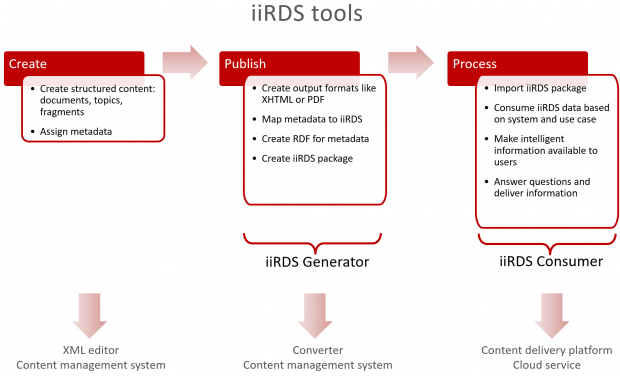iiRDS: We answer your questions
iiRDS enables the delivery and exchange of intelligent information. The standard has been developed by tekom (tcworld)since 2016. With the help of iiRDS, we can link content from different manufacturers using metadata, make the content accessible to machines and people in a targeted manner, and exchange it between systems via standard format.
Since the beginning, parson has been involved in the development and documentation of the standard. At conferences and talks, we report on the status of the development and its practical application. In this blog, we want to answer some of the most frequent questions we have been getting.
Your questions
- How can I create iiRDS packages?
- How do I create iiRDS from a component content management system?
- Do I need to assign all metadata manually?
- Which companies already use iiRDS?
- Do I need a content management system to use iiRDS?
- Do I have to use all iiRDS metadata?
How can I create iiRDS packages?
Now you can create iiRDS packages with the iiRDS Open Toolkit. You don't need to be an expert for this. This is how it works:
- Open the iiRDS Open Toolkit web application.
- Upload content.
- Assign the iiRDS metadata. You can also add your own metadata.
- Generate the iiRDS package.
To have a look inside the iiRDS package, change the file extension from .iirds to .zip. Now you just have to unpack the package. Then you will see the folder structure, the contents and the metadata file of your iiRDS package.
The iiRDS Open Toolkit was developed by plusmeta GmbH and ICMS GmbH. The iiRDS OT is free of charge.
You can find more information in this plusmeta blog post (in German) and on the iiRDS website.
How do I create iiRDS from a component content management system?
If you work with a component content management system (CCSM), then you are already well prepared for delivering smart content. Because you already work with modular content and can use metadata. The concept of creating iiRDS packages from a CCMS is as follows:
(1) You define the metadata that you need for your content delivery scenarios. Example: Some of the users of your documentation portal are service technicians and should only see content that matches their role. That means you need metadata describing the target audiences of the documentation.
(2) You implement this metadata in your component content management system. There are two approaches for this, which can also be combined:
- You use the metadata concept of your CCMS and map the content delivery metadata to iiRDS in the iiRDS generation (step 5 in this list).
- You redesign your metadata concept for content delivery and adapt your metadata schema to iiRDS.
(3) You assign the defined metadata to the content in the CCMS. (4) You configure the iiRDS output in the CCMS. That includes:
- Mapping your CCMS metadata to the iiRDS standard metadata that you want to deliver together with the content. This may be, for example, metadata about product lifecycle phases or information types.
- Configuring the iiRDS output for metadata that is not covered by the iiRDS standard, but require extensions. To go back to the service technician example: The standard metadata DocumentationMetadata > FunctionalMetadata > Qualification > Role is just an empty docking point in iiRDS. You need to extend the iiRDS metadata model with your target group “service technician” by adding the instance “service-technician” to the class Role.
(4) You create an iiRDS package from the CCMS.
The number of component content management systems with integrated iiRDS support is still limited. As far as we know, the following CCMS directly support iiRDS. If you know of more, please comment and we’ll add them to the list.
- TIM by fischer
- Docuglobe by GDS
- Content Lifecycle System (CLS) by Empolis (in German only)
If your CMS does not support iiRDS, you can develop your own converter to export data and create the iiRDS package. Most CMS offer corresponding export interfaces (APIs). Also, consultants like parson or ICMS or software vendors like plusmeta or c-rex.net can help.
Do I need to assign all metadata manually?
No, and for several reasons:
(1) Usually, you only use a subset of the iiRDS metadata. Which subset that is depends on your content-delivery scenarios. Examples:
- You want the users of your documentation portal to only see content that matches their role, for example, service or sales. That’s why you need metadata for the target group of the documentation.
- You want the users of your documentation to be able to filter by product. That’s why you need product metadata.
(2) A lot of metadata that is in the iiRDS package and delivered with the content, is automatically created:
- By your authoring system from the metadata that you use for tagging variants.
- By your authoring system from the content types and content templates that you use for writing. Examples: templates for topic types, fragment types, and warning messages.
- From the document structures and directories that you create in the authoring system, like table of contents, list of tables, and list of images.
(3) Metadata for topics or fragments can be inherited from parent elements during the iiRDS generation, for example from chapter elements or information products.
The iiRDS format just defines the metadata. Because iiRDS is not an authoring standard, it does not define how you assign and use the metadata.
Which companies already use iiRDS?
Several companies use iiRDS or are working on the implementation of the standard. Prominent examples are Siemens, SMA, and Zeiss. You can find more information, for example, in presentations by these companies and consultants at the tcworld conference and on the website of the iiRDS consortium (best practices).
Zeiss and Pantopix
Siemens, IAI Linguistic Content, and DOSCO
iiRDS in selected industries
Do I need a content management system to use iiRDS?
No. Basically, you need the following tools for iiRDS:
- XML editor for creating structured content and assigning metadata. You can also create structured content with iiRDS metadata with an XML editor without a content management system, e.g. in DITA with oXygen. Here you need a DITA specialization for the iiRDS metadata. You can develop the specialization yourself or use ready-to-use plug-ins.
- Converter for generating the output formats and the iiRDS packages. To generate iiRDS packages, also from existing documents into PDF, you can also use converter tools by plusmeta or c-rex.net.
- Content delivery platform to import and process the iiRDS packages and publish the intelligent information
Do I have to use all iiRDS metadata?
No. You can select the metadata that matches your content delivery scenarios.
Use the metadata that makes your content more discoverable and filterable for your target audiences. By the way, in the iiRDS specification, all mandatory elements of the standard are marked as MUST. There are only very few of them. Among other things, the directory structure in the iiRDS package must be adhered to and each information unit must have a unique identification (IRI). See iiRDS specification (registration required).
Do you also have a question about iiRDS?
Please use the comment form or write us at contact@parson-europe.com .
You also find more information about iiRDS on our website.



